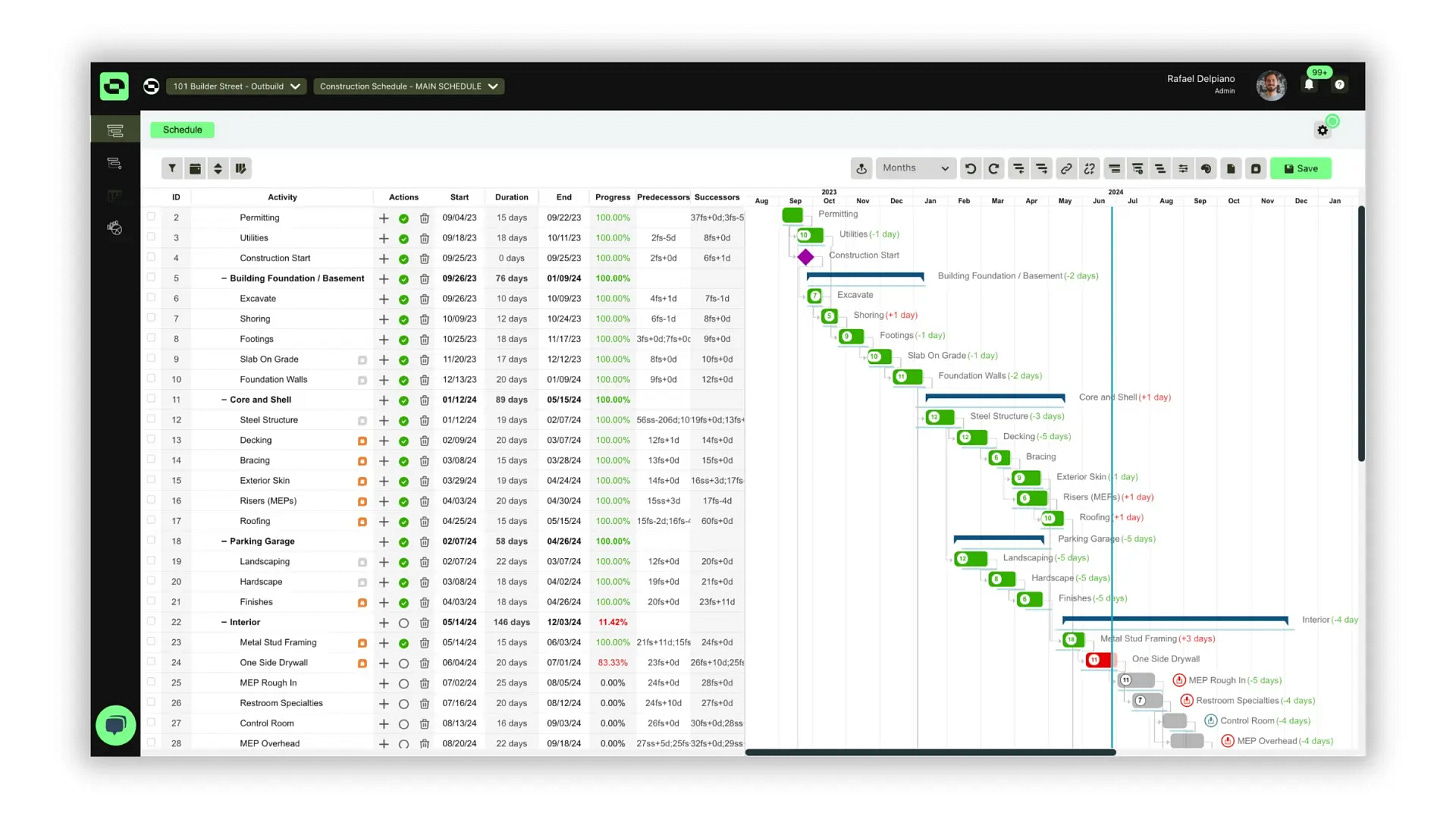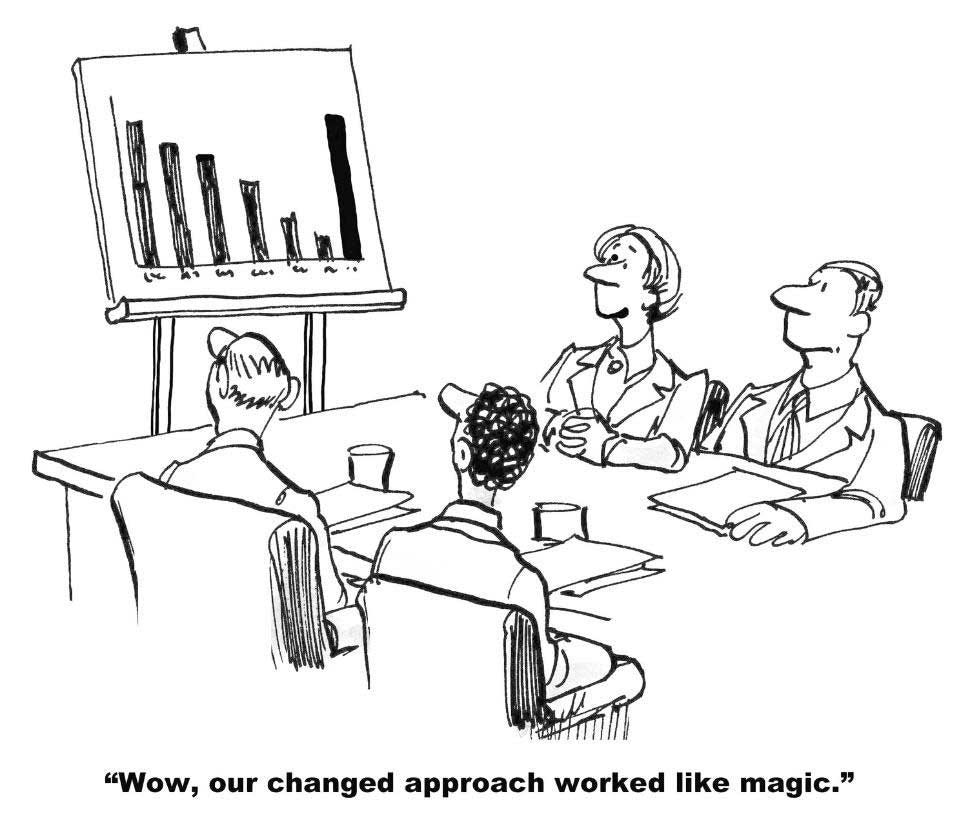How to Know If Your Project Is Winning (Or Losing)
The Project Scorecard: Why it matters, how to build one, and what it tells you.
👋 Hey, Kyle here! Welcome to The Influential Project Manager, a weekly newsletter covering the essentials of successful project leadership.
Today’s Overview:
Are you running your project without a clear way to tell if it’s actually winning or losing?
Most teams rely on lagging indicators, last-minute gut checks, or scattered updates—until it’s too late to course-correct.
This week, I’ll show you how to build a simple Project Scorecard—a real-time dashboard of leading indicators that helps you predict problems, drive accountability, and lead with clarity.
🏗️ PERFECT YOUR PLANNING ROUTINE WITH OUTBUILD!
Helping projects prevent delays to stay on schedule.
Outbuild is designed for one thing: to make construction scheduling simple, connected, and effective. It’s the trusted choice of top contractors. Here’s why:
✅ User-Friendly: Intuitive drag-and-drop features let your team get started immediately without any long training sessions.
✅ Collaborative: Everyone—from trade partners to PMs and PEs—can log in, plan their work, and communicate directly in one centralized platform.
✅ Integrated: Outbuild syncs effortlessly with Procore and others, keeping all your project workflows in one place.
✅ Real-time Insights: Powerful reporting and analytics track progress, delays, and resource usage, empowering you to make fast, informed decisions.
Outbuild lets you manage projects better so you can focus on what truly matters.
👉 Book a live demo (30 day free trial included). iPM subscribers get a 15% discount on the first year license.
DEEP DIVE
🏆 How to Know If Your Project Is Winning (Or Losing)
Filed under: Frameworks & Tools, Project Management
Imagine you’re halfway across the Atlantic ocean in a small plane.
The captain comes over the intercom:
“I’ve got good news and I’ve got good news. The bad news is the gauges aren’t working. We are hopelessly lost, I have no idea how fast we’re flying or in what direction, and I don’t know how much fuel we have left. The good news is we’re making great time!”
Does that sound familiar?
That’s how most project managers run their projects. They’re flying blind with no data to let them gauge where they are, where they are going, or if they are heading in the right direction. But they always remain optimistic.
Let’s change that.
Stop Managing Opinions. Start Managing the Score.
Today’s tools is simple but powerful:
📊 The Project Scorecard.
It’s a weekly dashboard of 5–15 weekly numbers that give you a live pulse on your job.
When you lead with numbers, you stop flying blind. You stop leading with assumptions, emotions, and egos—and start leading with clarity and confidence.
A strong scorecard makes success visible. It tells you, in real time:
What’s on track
What’s off track
Where to focus next
Even better? When everyone on your team owns a number—something clear, meaningful, and measurable—you create alignment, accountability, and momentum.
And over time, this simple scorecard becomes your crystal ball. It reveals patterns. Highlights risks. And helps you make smarter decisions, faster.
Unfortunately, most teams don’t use a scorecard. At best, they track lagging indicators—like the monthly P&L or a last-minute schedule slip. But by the time those show up, it’s already too late. That’s the past. You can’t change it.
A scorecard, on the other hand, helps you shape the future.
And no two projects will have the exact same scorecard. The best ones are designed by the people doing the work—for their project. Because there’s a big difference between the scoreboard a coach looks at and the one the players actually use to win the game.
The Project Scorecard Framework
There’s an old business maxim: what gets measured and watched gets improved.
The same holds true in project management. The minute you start measuring the right numbers, performance improves. Teams move faster. Problems surface earlier. Accountability kicks in.
The right kind of scorecard motivate players to win. People and teams play differently when they are keeping score. If you doubt this, watch a group of teenagers playing pickup basketball. See how the game changes the minute scorekeeping begins.
The following exercise will be show you a step-by-step process for creating a scorecard that fits for your project.
Step 1: Define what to track
Spend an hour with your project leadership team.
Then imagine this: You’re stranded on a desert island. None of you can talk to anyone, access e-mail, or phone. All you have is a piece of paper with a handful of numbers on it. These numbers must allow you to have an absolute pulse on your project.
What are the numbers that must be on that piece of paper? Decide and list all the categories that you’d be need to track on a weekly basis to have that pulse.
These core indicators might include:
As a rule of thumb, you should end up with about 5 to 15 numbers, hopefully closer to five. There is such a thing as too much information, so keep it simple.
Once you’ve aligned on the key categories, plug them into your scorecard template (I run mine inside Notion using my ProjectOS system.)
Step 2: Assign Accountability
In the left-hand column, list who is accountable for each of the numbers.
Only one person is ultimately responsible for each, and it’s usually the person heading up that major function of the project.
This is the person who must deliver that weekly number to the project, not the person who simply enters the number. For example, the lead superintendent is accountable for hitting the PPC activity numbers, not the project engineer who fills out the scorecard each week.
Step 3: Set Weekly Targets
Next to each metric, define what success looks like—what’s the goal for this weekly?
These targets should be directly tied to your milestone schedule or 90-day project plan. This is where alignment happens: what’s expected vs. what’s achieved.
Step 4: Set It Up
Build your scorecard into a recurring tool.
Notion, Excel, a whiteboard—whatever your team will actually use every week.
Add a column for next week’s date. Set it up now so it’s ready to track every week going forward.
Step 5: Assign the Data Collector
Decide who’s responsible for gathering the metrics each week.
This person should know how and where to get the numbers—and have a simple process for collecting them from each accountable leader.
If it’s clunky, it won’t stick. Make it easy and repeatable.
Step 6: Use It Every Week
The real value is in review. During your weekly leadership meeting, go line by line:
What’s on track? Mark it green.
What’s off track? Mark it red.
What needs attention now? Take aligned action.
The real magic of using a scorecard is not limited to managing it on a weekly basis. You will soon see 13 weeks (three months) at a glance, which enables you to see patterns and trends.
🎯 The Goal: Everyone Has a Number
“Great teams know at every moment whether or not they are winning. They must know, otherwise, they don’t know what they have to do to win the game.” - Chris McChesney, Co-author of The 4 Disciplines of Execution
Your project becomes truly performance-driven when every team member owns a single number—a clear, meaningful, manageable metric that tells them (and you) whether they’re winning.
In fact, there are eight clear advantages to everyone having a number:
Numbers cut through murkey subjective communication between manager and direct reports.
Numbers create accountability.
Accountable people appreciate numbers.
Numbers create clarity and commitment.
Numbers create competition.
Numbers produce results.
Numbers create teamwork.
You solve problems faster.
With the right numbers in place, your team can’t hide. And they won’t want to. They’ll know what winning looks like—and how to get there.
Here’s Why I Bring This Up…
If you’ve ever felt like you were reacting instead of leading…
If you’ve relied too long on gut checks instead of real checks…
Or if you want a simple, reliable way to track what matters most each week…
Check out Outbuild.
Outbuild gives you live, visual feedback on your schedule performance—so you always know what’s on track, what’s slipping, and what needs your attention.
It includes metrics like:
Percent Plan Complete (PPC)
Percent Roadblock Removed (PRR)
S-Curve tracking
Reasons for variance
And it makes scorecarding dead simple.
If you're building your own project scorecard—or want a better way to manage one—Outbuild is the next step (iPM subscribers get 15% off their first-year license).
Until next week,
Kyle Nitchen

Whenever you’re ready, here are 4 ways I can help you elevate:
Read my Book. No Bullsh*t Project: A Project Manager’s guide to successful project leadership.
Install ProjectOS. My complete operating system for project leaders and their teams. A done-for-you toolkit—templates, agendas, KPI’s, and workflows—to run complex projects like a pro. (Our most popular product).
Join Antifragile Project Management. My flagship program for supercharging your project leadership. This complete system combines training, software, and community to help you master the craft, think like an owner, and lead high-performing, antifragile projects. Book a discovery call to learn more.
Promote Your Business. Get your brand in front of 7,500+ construction leaders and decision-makers. Highly engaged. 51% open rate.








